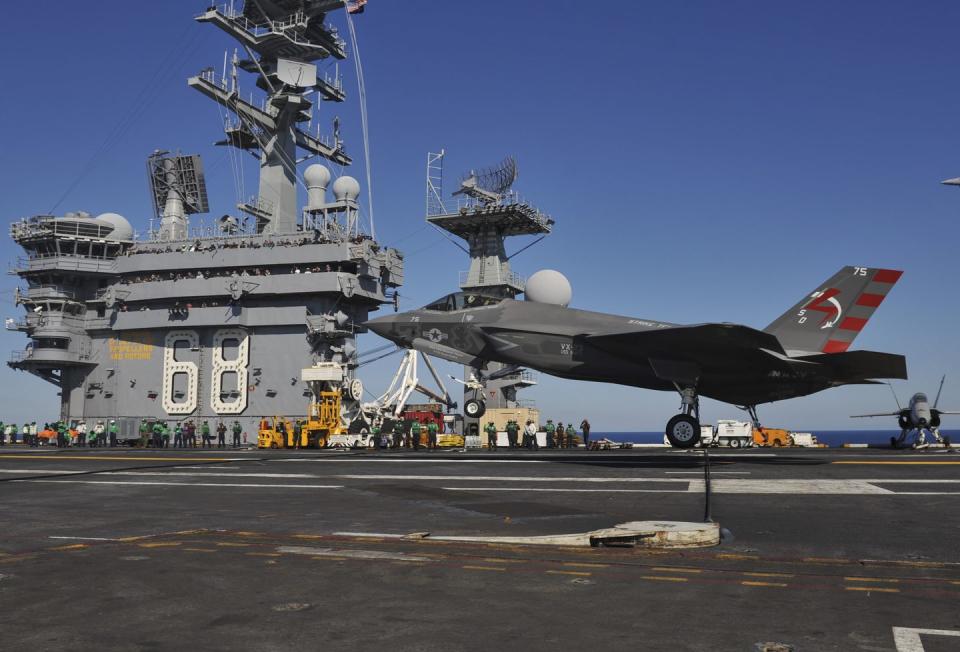Say Hello To America’s Newest Aircraft Carrier, the USS John F. Kennedy
This past weekend the USS John F. Kennedy was christened at Newport News, Virginia.
The ship is the second Ford-class aircraft carrier.
Although the ship was christened today, Kennedy won’t join the fleet until the 2020s.
On Saturday, the daughter of former President John F. Kennedy presided over the christening ceremony for America’s newest aircraft carrier. Former first daughter Caroline Kennedy, swinging a magnum bottle of champagne, dedicated the second aircraft carrier named after her father, a former naval officer who served during World War II.

The future USS Kennedy is the second ship to bear the President’s name and the second Ford-class aircraft carrier.
The ceremony was held at Huntington Ingalls Industries’ Newport News Shipyard in Virginia. Kennedy is a member of the new Ford-class of aircraft carriers, which will replace the Nimitz-class carriers currently serving with the U.S. Navy. Kennedy will replace the Nimitz sometime in the early to mid-2020s. USS Nimitz is the oldest carrier in the Navy, having served continuously since May 1975.

The big carrier is not yet officially part of the U.S. Navy. Kennedy’s drydock was recently filled with water, allowing the ship to float on its own. Although the ship is structurally complete, it’s basically empty inside, so the shipbuilders will spend the next few years fitting it out. After that it’s shipbuilder’s trials, with contractors taking the ship to sea to test major equipment.
If the contractor’s trials pass smoothly then the Navy will finally commission the carrier in the early 2020s. The ship is known for now as Pre-Commissioning Unit Kennedy, taking the United States Ship title only after commissioning. The Navy next holds its own trials, and barring any problems Kennedy will go on its first patrol shortly thereafter.

PCU Kennedy is 1,092 feet long and displaces 100,000 tons fully loaded. The ship itself is in many ways similar to U.S. carriers of the last sixty years, with the ability to launch up to four aircraft at a time, an expansive hangar to store and maintain aircraft, a nuclear reactor, and self-defense guns and missiles.
The Ford class, however, is built with an electromagnetic aircraft launch system, new aircraft landing system, improved nuclear reactor, and improved radar system. The Navy claims that the Ford class will be able to generate 33 percent more aircraft sorties for less money, saving $4 billion over the life of the carrier compared to older Nimitz ships.
But the real star of the carrier is the future air wing. Kennedy will embark approximately 70 aircraft, divided into squadrons and detachments. Each air wing consists of four strike fighter squadrons totaling 44 fighters. Currently those squadrons are filled with F/A-18E and F/A-18F Super Hornet fighters.
In addition there’s one electronic attack squadron with five EA-18G Growler electronic attack aircraft, one carrier airborne early warning squadron with four E-2 Hawkeye early warning aircraft, one helicopter sea combat squadron with 8 MH-60S Seahawks, one helicopter maritime strike squadron with 11 MH-60R Seahawks, and two C-2A Greyhound carrier transports.
Kennedy will serve for 40-50 years and will see considerable changes during its lifetime. At some point, probably in the late 2020s, Kennedy will upgrade its strike fighter squadrons from four squadrons of Super Hornets to a mix of two Super Hornet and two F-35C Joint Strike Fighter squadrons. The F-35C is the Navy’s first fifth-generation fighter and the first stealthy fighter to go to sea. Around that time, the ship will also likely embark MQ-25 Stingray unmanned aerial refueling tankers, extending the operational range of the strike fighters. At some point the ship will likely trade in Evolved Sea Sparrow and RAM anti-missile missiles for short-range defensive lasers, though the timeline for this is a lot less clear.

Kennedy is cruising in its predecessor Ford’s wake. The USS Ford encountered significant problems during construction, and still faces problems even after after commissioning. Issues with the ship’s electromagnetic launch system, advanced arresting gear, and in particular its advanced weapon handling elevators caused years of delays and hundreds of millions in cost overruns. Even today only four of the ship’s eleven electromagnetically powered weapon elevators are operational. Internally, Kennedy has a very similar layout to the Ford and if the problems on Ford aren’t fixed, they will probably stymie Kennedy as well.
The U.S. Navy will eventually build ten or more Ford-class carriers. The next ship will be named the USS Enterprise.
Source: U.S. Naval Institute News
You Might Also Like

